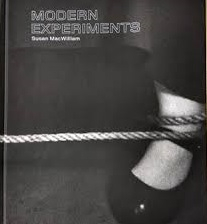
Reviewed by Shannon Taggart
Modern Experiments documents the artist Susan MacWilliam’s retrospective exhibition that toured her homeland of Ireland during 2016–2017. MacWilliam’s videos, photographs, sculptures and installations are inspired by parapsychology, and her raw material is largely drawn from the field’s most important archives and libraries, including those held at Duke University, Durham, North Carolina and the University of Manitoba, Winnipeg. The book is a teaser for an expansive body of work that spans 18 years, some of which was included in the 53rd Venice Biennale, the world’s most prestigious visual arts event. Images, essays, a timeline and a summary index both introduce MacWilliam’s art to the uninitiated and provide an overview for those already familiar. The pieces themselves — represented by details, installation shots or video stills — highlight the strange equipment, absurd aesthetics and compelling characters found throughout the history of psychical research. As a whole, MacWilliam’s oeuvre examines the psychological complexity of the parapsychological record.
MacWilliam addresses parapsychology’s marginal status. Believers in the paranormal and academic researchers alike have distanced themselves from the discipline due to its failure to gain respectability among scientists. Many artifacts related to paranormal activity have been devalued in the light of their evidential shortcomings. However, MacWilliam confronts and grapples with the visual potency and high strangeness of this material. She explores the unique theater created by the study of psychic phenomena. Her eye is attuned to the products of clairvoyance, ectoplasm, telepathy, x-ray vision, ESP, table-tipping, remote viewing, physical mediumship and fingertip perception. Throughout the book, startling images such as Kuda Bux’s facial blindfold, Rosa Kuleshova’s light-tight goggles and improvised paper collar, Kathleen Goligher’s customized foot trap and Helen Duncan’s roped ankles cast the pursuit of psychic knowledge as impolite, silly and unsettling.
As an artist, MacWilliam can mine data in a way a scientist cannot: emotions, opinions, anecdotes and aesthetics are all fair game. In F-L-A-M-M-A-R-I-O-N (2009), MacWilliam meditates on a famous example of ‘teleplasm’ while simultaneously creating a touching portrait of Dr. William G. Roll (1926–2012) that brings to life his boyish charm and genuine enthusiasm for the topic. In An Answer is Expected (2013), MacWilliam pairs images of parapsychology equipment and ephemera along with vocal recordings of prominent investigators. The resulting video collage animates the obsessive quest for answers and the persistent curiosity of those involved with the study of the paranormal. MacWilliam draws analogies between the artist and the psychical researcher, noting how each asks questions of the world that challenge mainstream thought, not knowing what the outcome will be. In Dermo Optics (2006), colorful objects, disembodied hands and small curtained stages make a playful association between the artist’s studio and the researcher Madame Yvonne Duplessis’s fingertip perception laboratory in Paris.
MacWilliam finds her most formidable muse in the famed Irish medium, Eileen Garrett (1893–1970). Garrett found her own paranormal experiences so perplexing that she founded the Parapsychology Foundation and the Creative Age Press to probe the topic by both science and art. In Garrett, MacWilliam has found the ideal figure to inspire discussion about the relationship between charisma, creativity and psychic functioning. Along with parapsychology luminaries Harry Price and J. B. Rhine, and visionaries including Aldous Huxley and Salvador Dalí, MacWilliam joins the parade of curious minds desperate to ‘get to Garrett’ — a phrase that repeats in one of her works. In videos such as Eileen (2008), MacWilliam and Garrett’s daughter, Eileen Coly, and granddaughter, Lisette, conjure up the spirit of Eileen Garrett like mediums. Through these intertwined interviews and archival images, Garrett’s enigmatic persona calls out, post-death, to be studied yet again.
For those interested in psychical research, the art world is important territory. Historians have acknowledged that psychic functioning spurred the very birth of modern art. The first abstract artworks are now accepted to be paintings produced by mediums in trance, such as those by Hilma af Klint and Georgiana Houghton. Despite their disinterest in arguing for or against the reality of the paranormal, contemporary artists who draw inspiration from the history of psychical research — including Tony Oursler, Brian Catling, Zoe Beloff, and Susan MacWilliam — have something to offer the parapsychology community. By mining the parapsychological storehouse for inspiration and reinterpreting its lost relics, interest is sparked and new conversations are inspired. This positive attention may be just what keeps the entire record safe from the dustbin and, ultimately, oblivion. As science spurns parapsychology, artists like MacWilliam may become the unlikely keepers of its legacy.
Susan MacWilliam engages with psychical research through storytelling, portraiture and reconstruction. By reframing parapsychological material, she revives unanswered questions regarding perception, the limits of our senses, the relationship between the body and psychic communication and the curious role of the researcher. MacWilliam’s art expands parapsychology’s audience, inviting new spectators to enter para-history and investigate the unknown.
Shannon Taggart is an artist based in Brooklyn, NY.

